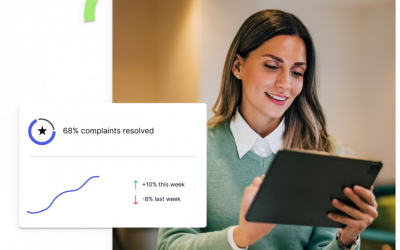Most high-performing organizations have engagement surveys to identify employee sentiment issues. However, many miss the opportunity of using data analytics to overlay employee survey responses with quantitative data sourced from disparate HR systems and business performance metrics. A next-generation people analytics strategy leverages technology to unlock the power of consolidating all of your data into a single source of truth—and then taking action.
The business case for comprehensive people analytics
Employers with a savvy people analytics strategy and the ability to glean insights from all their data have an advantage over those who don’t. People analytics drives objective, data-based workforce decisions by allowing organizations to mine data from every point in the employee life cycle, identify trends, and view real-time insights.
People analytics is key to data-driven decision making, especially in a world of fierce competition for top talent, remote work challenges, mental health service shortages, DEI shortfalls, and tedious SEC human capital reporting requirements.
Given the complexities and demands of today’s human capital, it’s easy to see why leading employers recognize the value of people analytics. In fact, the top jobs on the rise in the U.S. in 2023 include:
- HR Analytics Manager (#2)
- Diversity and Inclusion Manager (#3)
- Employee Experience Manager (#5)
Disparate employer data sources present opportunities
When we talk about “bringing data together,” there are a number of sources that can be included. We can broadly divide them into the following categories:
- Business performance: This includes operational and financial data, such as overall revenue, profit margin, earnings per share, sales figures, and productivity metrics, along with customer loyalty and satisfaction ratings.
- Workplace monitoring: Examples of these business metrics include flight risk, open recs, time to fill, productivity, absenteeism, safety incidents, terminations, DEIB goals, and training participation.
- Employee sentiment: This information comes directly from employees. People reveal sentiment and engagement insights through surveys, performance reviews, focus groups, NPS scores, and exit interviews.
By bringing disparate metrics together, organizations can derive more meaningful takeaways. For example, organizations with high engagement have discovered 81% lower absenteeism, 64% fewer safety incidents, and 23% higher profits compared to those with low engagement.
Analyzing business performance and workplace data alongside employee survey results helps identify crucial indicators, trends, and connections. These data-driven insights can inform decision making and help quantify outcomes of hard-to-measure initiatives, such as productivity and recruiting.
How to bring your data together to discover actionable insights
Collecting relevant data from diverse sources is the first step in deploying your people analytics strategy. Here’s how you can bring that data together to drive your decision making.
Listen holistically to your employees
A comprehensive people analytics strategy should include a holistic listening approach. This means combining active listening through employee surveys with passive listening, such as meeting participation and absenteeism metrics. Together, the data-driven, real-time passive listening metrics complement the self-reported, lagged active listening insights to create a comprehensive data set for the full population.
Use people analytics technology to transform and cross-analyze data
Next-level people analytics technology allows organizations to gather data from various sources, consolidate it, and cross-analyze it to identify correlations and patterns. Too much data and too many sources make analysis and storytelling ineffective and time consuming. Fortunately, comprehensive solutions like ZeroedIn can create a single source of truth.
With the right technology, analytics teams can derive meaningful takeaways by bridging siloed metrics together, such as employee sentiment and business performance data. As an example, organizations can compare low engagement scores to sales and turnover in a given location or department, or high sentiment with productivity data and performance scores by manager or segment. Based on these insights, informed decisions can be made to improve the employee experience and output—rewarding top performers, implementing training programs or employee wellness initiatives, or making proactive recruitment strategy changes.
Case study: Williams-Sonoma
Williams-Sonoma, a specialty retailer of high-quality home products and furnishings, is an example of an organization that had the right data—but was struggling to effectively integrate retail and HR analyses. With 530 locations and 21,000 employees, the sources and metrics were so vast that making sense of them and finding key takeaways proved to be a challenge. Read how ZeroedIn’s Analytics Platform helped Williams-Sonoma achieve higher efficiency and hard dollar savings by reducing employee turnover and optimizing top performers.
Empower your data with ZeroedIn
In today’s business landscape, a comprehensive people analytics strategy is essential for making data-driven decisions about the people who power your organization. Leveraging data from various sources allows organizations to better understand employees and make evidence-based decisions to drive business success.
At ZeroedIn, our focus isn’t just collecting data, but enabling you to bring it all together and derive actionable insights. Our dynamic employee survey solution has the option to seamlessly integrate with our intuitive people analytics software, unlocking the power of consolidated quantitative and qualitative data. Contact us today to learn more.




